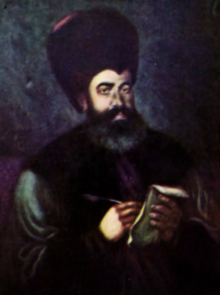| Radu Golescu-Știrbei | |
|---|---|
 Anonymous contemporary portrait, c. 1800 | |
| Great Ban of Oltenia | |
| Reign | 1799–1800 |
| Predecessor | Unattested |
| Successor | Unattested |
| Reign | June–August 1813 |
| Predecessor | Georgios Argyropoulous |
| Successor | Constantin Crețulescu |
| Reign | c. October 1818 |
| Predecessor | Unattested |
| Successor | Unattested |
| Born | May 3, 1746 Oltenia?, Wallachia |
| Died | October 8, 1818 (aged 72) Bucharest, Wallachia |
| Burial | |
| Spouse |
Zoița (Zinca) Floreasca
(died 1804) |
| Issue |
|
| House | Golescu (Știrbei) |
| Father | Nicolae Știrbei |
| Mother | Anița Goleasca |
| Religion | Orthodox |
Radu Golescu-Știrbei, historically known as Radul or Răducanul Golescul (Cyrillic: Радꙋ̆л[1] or Ръдуканꙋ̆л Голєскꙋ̆л;[2] 3 May 1746 – 8 October 1818), was a Wallachian statesman, entrepreneur and philanthropist; he was the maternal grandson of Spatharios Radu Leurdeanu Golescu, as well as the father of the writers Iordache and Dinicu Golescu. His life, as well as his participation in government, coincided with the Phanariote reigns, by Greek or Hellenized Princes acting under Ottoman suzerainty. Himself educated in Greek, Golescu was a native boyar, and, like his sons, tended to side with the early manifestations of Romanian nationalism; he was especially prone to economic nationalism—though he alternated this commitment with episodes of participation in Phanariote spoliation, and was vilified as such by Wallachia's taxpayers. Before his political ascent, he established reputation as a businessman and early capitalist, investing in lucrative exports and helping to expand his family manor in Golești. Especially in his final decade, Golescu reinvested much of his wealth into the social uplift of peasant communities, building several rural schools and sponsoring the printing of books.
Golescu's rise began in the early 1780s, when he took over as Spatharios, also overseeing work on the Old Princely Cort of Târgoviște; he remained associated with Dâmbovița County, especially as its Ispravnic (sheriff), in which capacity he served until being deposed by the Ottomans in the Russo-Turkish War of 1787. From 1794, he received a role as foreign-policy overseer, or Great Logothete, and, in 1799–1800, served his first term as Great Ban of Oltenia. During these terms, he was also head of a token Wallachian military force assisting the Ottomans against the rebellious warlord, Osman Pazvantoğlu. Chased out of the country in 1802, when parts of Wallachia were sacked by Pazvantoğlu, he spent some years in relative isolation, including after his return; his sons also took up politics, climbing into the middle and higher reaches of administrative boyardom. During the war of 1806–1812, Golescu pledged himself to the Russian Empire, though he was marginalized within the administrative apparatus of Russian-occupied Wallachia. As an adversary of the returning Prince Constantine Ypsilantis, he opted to go into his second exile, to Moldavia.
Golescu returned to Wallachia under the subsequent reign of John Caradja, who tasked the former Ban with sanitation work, which was supposed to contain the eponymous plague. Rewarded with a second and third terms at the Banship, he was later briefly the Wallachian treasurer (Vistier), in which capacity he supported some of Caradja's most controversial practices. He and Iordache were ultimately sidelined in 1817, following Caradja's definitive clash with the nationalists. Ban Golescu died shortly after, with his funeral being the last public function attended by Caradja, who then fled Wallachia. The junior Golescus endorsed a return to their father's economic policies, trying to obtain support for them during the Regulamentul Organic regime in the 1820s and '30s. Radu's many grandsons embraced liberal radicalism, with most of them playing parts in the Wallachian Revolution of 1848.